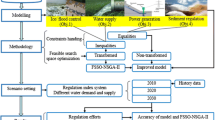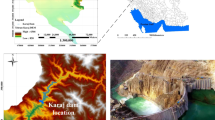Abstract
In this study, the non-dominated sorting genetic algorithm (NSGA-II) is used for the multi-objective optimization of the Sefidrud reservoir in Northern Iran. The main objectives include water supply, hydropower generation and sediment flushing. In addition to some physical constraints such as the reservoir storage and the outlet flow, maximum flushing outflow and non-flushing in irrigation seasons, the environmental constraints as fish migration and spawning are taken into an account. After obtaining the Pareto optimal solutions by means of the weighted objective functions and non-symmetric Nash bargaining, various scenarios are defined. Then these scenarios are analyzed by introducing a new sustainability index. Furthermore, the different percentages of downstream water demand are considered in order to achieve a better evaluation of the scenarios. The results of study indicate that the optimal solutions are more sustainable than those of the current operation of Sefidrud reservoir, which increase the sediment flushing by 37 million tons compared to the current operation, with the same hydroelectric energy and downstream water supply. The proposed methodology could be used successfully in other reservoir operations including the sediment flushing.
















Similar content being viewed by others
References
Afshar MH, Rajabpour R (2008) Application of local and global particle swarm optimization algorithm to optimal design and operation of irrigation pumping systems. Irrig Drain 58:321–331
Atkinson E (1996) The feasibility of flushing sediment from reservoir. HR Wallingford Ltd, UK TDR Project R5839
Celeste AB, Billib M (2009) Evaluation of stochastic reservoir operation optimization models. Adv Water Resour 32:1429–1443
Chang LC, Chang FJ (2009) Multi-objective evolutionary algorithm for operating parallel reservoir system. J Hydrol 377:12–20
Chang FJ, Chen L, Chang LC (2005) Optimizing the reservoir operating rule curves by genetic algorithms. Hydrol Process 19:2277–2289
Chang LC, Chang FJ, Wang KW, Dai SY (2010) Constrained genetic algorithms for optimizing multi-use reservoir operation. J Hydrol 390:66–74
Chang JX, Bai T, Huang Q, Yang DW (2013) Optimization of water resources utilization by PSO-GA. Water Resour Manag 27:3525–3540
Chavez HML, Alipaz S (2007) An integrated indicator based on basin hydrology, environment, life, and policy: the watershed sustainability index. Water Resour Manag 21:883–895
Chen L (2003) Real-coded genetic algorithm optimization of long-term reservoir operation. J Am Water Resour Assoc 39(5):1157–1165
Chen L, Mcphee J, William W, Yeh G (2007) A diversified multiobjective GA for optimizing reservoir rule curves. Adv Water Resour 30:1082–1093
Coello Coello CA, Lamont BG, Van Veldhuizen (2007) Evolutionary algorithms for solving multi-objective problems (2nd edition). Springer
Deb K (2001) Multi-objective optimization using evolutionary algorithms. John Wiley & Sons
Deb K, Pratap A, Agarwal S, Meyarivan T (2002) A fast and elitist multiobjective genetic algorithm: NSGA–II. IEEE Trans Evol Comput 6(2):182–197
Di Pierro F, Kho ST, Savic D, Berardi L (2009) Efficient multi-objective optimal design of water distribution networks on a budget of simulations using hybrid algorithms. Environ Model Softw 24:202–213
Fallah-mehdipour E, Bozorg Hadad O, Marino MA (2011) MOPSO algorithm and its application in multipurpose multireservoir operations. J Hydroinf 13(4):794–811
Hakimi-asiabar M, Ghodsypour SH, Kerachian R (2009) Multi-objective genetic local search algorithm using Kohonen’s neural map. Comput Ind Eng 56:1566–1576
Hakimi-asiabar M, Ghodsypour SH, Kerachian R (2010) Deriving operating policies for multi-objective reservoir systems: application of self-learning genetic algorithm. Appl Soft Comput 10:1151–1163
Harsanyi JC, Selten R (1972) A generalized Nash solution for two person bargaining games with incomplete information. Manag Sci 18(2):80–106
Hejazi MI, Cai X (2011) Building more realistic reservoir optimization models using data mining–a case study of Shelbyville reservoir. Adv Water Resour 34:701–717
Khan NM, Babel MS, Tingsanchali T, Clemente RS, Luong HT (2012) Reservoir optimization-simulation with a sediment evacuation model to minimize irrigation deficits. Water Resour Manag 26:3173–3193
Kourakos G, Mantoglou A (2013) Development of a multi-objective optimization algorithm using surrogate models for coastal aquifer management. J Hydrol 479:13–23
Liong SY, Md A (2004) Optimal design of water distribution network using shuffled complex evolution. J Inst Eng Singap 44:93–107
Liu Y (2009) Automatic calibration of a rainfall-runoff model using a fast and elitist multi-objective particle swarm algorithm. Expert Syst Appl 36:9533–9538
Loucks DP (1997) Quantifying trends in system sustainability. Hydrol Sci J 42:513–530
Malekmohammadi B, Kerachian R, Zahraie B (2009) Developing monthly operating rules for a cascade system of reservoirs: application of Bayesian networks. Environ Model Softw 24:1420–1432
Malekmohammadi B, Zahraie B, Kerachian R (2011) Ranking solutions of multi-objective reservoir operation optimization models using multi-criteria decision analysis. Expert Syst Appl 38:7851–7863
Montalvo I, Izquierdo J, Garcia RP, Herrera M (2010) Improved performance of PSO with self-adaptive parameters for computing the optimal design of water supply systems. Eng Appl Artif Intell 23:727–735
Raquel S, Ferenc S, Emery J, Abraham R (2007) Application of game theory for a groundwater conflict in Mexico. J Environ Manag 84:560–571
Revelle C (1999) Optimizing reservoir resources: including a new model for reservoir reliability. John Wiley & Sons
Safavi HR, Chakraei I, Kabiri-Samani A, Golmohammadi MH (2013) Optimal reservoir operation based on conjunctive use of surface water and groundwater using neuro-fuzzy systems. Water Resour Manag 27:4259–4275
Shokri A, Bozorg Hadad O, Miguel A (2013a) Reservoir operation for simultaneously meeting water demand and sediment flushing: stochastic dynamic programming approach with two uncertainties. J Water Resour Plan Manag 139:277–289
Shokri A, Bozorg Hadad O, Marino MA (2013b) Algorithm for increasing the speed of evolutionary optimization and its accuracy in multi-objective problems. Water Resour Manag 27:2231–2249
Solis S, Mckinney DC, Loucks DP (2011) Sustainability index for water resources planning and management. J Water Resour Plan Manag 137:381–390
Srinivas N, Deb K (1994) Multiobjective optimization using non dominated sorting in genetic algorithms. Evol Comput 2(3):221–248
Tang Y, Reed PM, Kollat JB (2007) Parallelization strategies for rapid and robust evolutionary multiobjective optimization in water resources applications. Adv Water Resour 30:335–353
Vrugt JA, Gupta HV, Bouten W, Sorooshian S (2003) A shuffled complex evolution metropolis algorithm for optimization and uncertainty assessment of hydrologic model parameters. Water Resour Res 39:1–16
Wang KW, Chang LC, Chang FJ (2011) Multi-tier interactive genetic algorithms for the optimization of long-term reservoir operation. Adv Water Resour 34:1343–1351
Wu W, Holger RM, Angus RS (2013) Multiobjective optimization of water distribution systems accounting for economic cost, hydraulic reliability and greenhouse gas emissions. Water Resour Res 49:1211–1225
Xu ZX, Takeuchi H, Ishidaira H, Zhang XW (2002) Sustainability analysis for Yellow river water resources using the system dynamics approach. Water Resour Manag 16:239–261
Zarghami M, Hajykazemian H (2013) Urban water resources planning by using a modified particle swarm optimization algorithm. Resour Conserv Recycl 70:1–8
Zarghami M, Ardakanian R, Memariani A, Szidarovszky F (2008) Extended OWA operator for group decision making on water resources projects. J Water Resour Plan Manag ASCE 134(3):266–275
Zongxue X, Jinno K, Kawamura A, Takesaki S, Ito K (1998) Performance risk analysis for Fukuoka water supply system. Water Resour Manag 12:13–30
Acknowledgments
The insightful comments of Dr. Nourani, the associate professor in the University of Tabriz and Mr. Asghari, as the head of Hydrology Section in the Sefidrud Dam are so appreciated.
Author information
Authors and Affiliations
Corresponding author
Rights and permissions
About this article
Cite this article
Hajiabadi, R., Zarghami, M. Multi-Objective Reservoir Operation with Sediment Flushing; Case Study of Sefidrud Reservoir. Water Resour Manage 28, 5357–5376 (2014). https://doi.org/10.1007/s11269-014-0806-9
Received:
Accepted:
Published:
Issue Date:
DOI: https://doi.org/10.1007/s11269-014-0806-9




